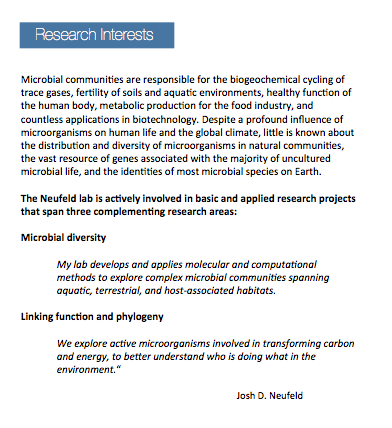 What lead you to follow Josh on Twitter?
What lead you to follow Josh on Twitter?
Josh belongs to the new generation of soil scientists able to bridge microbial ecology and environmental genomics. He has developed new tools to explore the active components of the microbial communities found in aquatic and soil environments. His ability to combine innovative experimental design, high-throughput sequencing technologies and isotopic tracers is unique. Josh’s paper in Nature Protocols on the DNA stable-isotope probing (DNA-SIP) has already collected more than 170 citations. I have thus followed Josh activities by reading his papers, but also on Twitter where he is very active in promoting microbiology and commenting on new ways of outreaching to students and the public.
How did your meeting come about?
Josh is enjoying a sabbatical leave in Lyon in Pascal Simonet’s lab — a long standing collaborator of our team. He contacted me a few months ago to visit our lab and discuss the best ways to promote mycology at the University of Waterloo; mushrooms present an excellent way to educate the public about microbes and about bridging fungal and bacterial ecology. This was a great opportunity to expose our students and colleagues to one of the most innovative scientists in the field.
What does Twitter represent for you as a scientist?
I have been promoting social networks in the lab and throughout my scientific community for over two years now, and not much from those discussions is met with more skepticism than when I say Twitter can be a great tool for science communication and outreach to students and the lay public. ‘No, you will not waste your time with Twitter. Twitter is not exclusively about self-promotion, it isn’t shouting or mindless small talk.’ Twitter is very powerful for keeping up with current events/research more broadly than is possible by journals alone. For me, it is the fastest means to breaking information and the quickest way to forward that news. Scientists use Twitter to follow conferences they can’t get to in person. Many scientists are now using Twitter to create and develop new collegiate relationships, foster interdisciplinary research and disseminate new ideas. Scientists-tweeps can also use this micro-blogging tool to get input from other researchers. It is an efficient way to approach networking and socializing.
Further thoughts on how social media is changing how we approach research and teaching?
As stressed by Jean-François Gariépy on his BrainFacts.org blog, “consistency, sharing of good peer-reviewed research, honest interventions and high-quality information. Those are exactly the characteristics we would be looking for when hiring a lecturer or professor. » In the age of social media, Twitter lets you communicate your science directly to the public. It allows scientists to teach, research and engage in a thought process within the public sphere.
_____________________________________________________________________________
Learn more about Josh Neufeld :
https://uwaterloo.ca/biology/people-profiles/josh-d-neufeld
Twitter: @joshdneufeld




